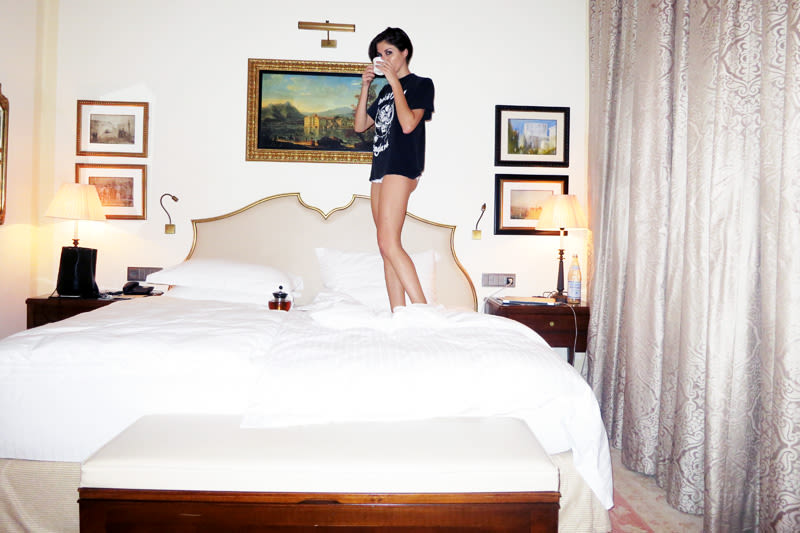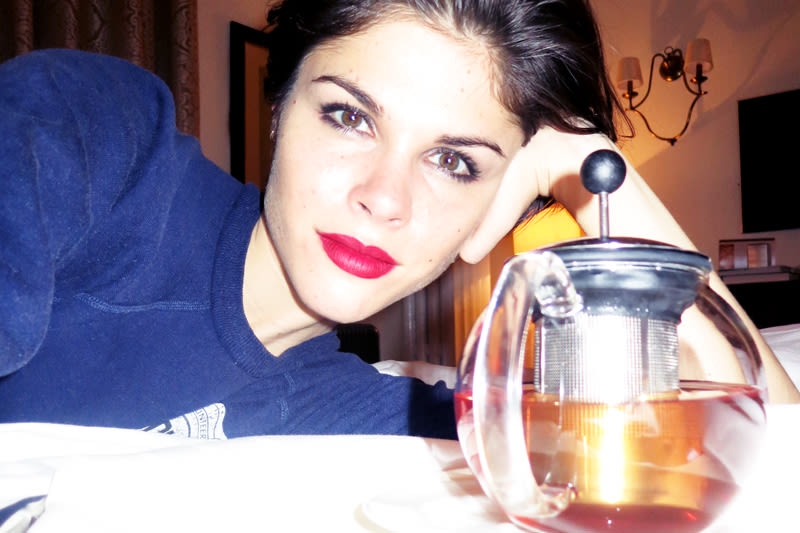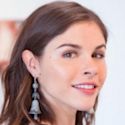“You’re going to detox…in Italy?” So said my friend Kerry, who owns one of my favorite restaurants, Seersucker, before I left. And it was Seersucker’s Instagram feed—a stream of buttermilk biscuits, fried chicken, rice pudding, and other food-porn close-ups—that I desperately scrolled through at 4 AM on day 3 of the Henri Chenot detox plan. That was a low point. I’d had “ pulga” for dessert that night, and if you think that’s Italian for some kind of tart, think again. It was a pile of white powder served in a glass goblet, very Scarface, delivered by a dapper gentleman with a “Bon appetite, Madame—good luck!” in the candlelit ballroom where I ate three meals a day by myself for a week between Christmas and New Year’s. I’d been served a hearty helping of laxatives like it was an ice cream sundae.
The Palace Merano, a five-star hotel housing the Espace Henri Chenot, is a wellness spa, medical spa, or detox center, depending on whom you ask, situated in the snowy South Tyrol region of Northern Italy. The destination—because that’s what it is, really—is the brainchild of wellness guru Henri Chenot, a serene seventy-year-old from Spain’s Basque country (a longtime student of Chinese medicine and psychology, he founded the Academy of Biontology, which studies the “evolution of psycho-physical ageing”), who, together with his wife Dominique, reside on a private floor of the Palace. L’Officiel’s Daphné Hezard originally tipped me off to Chenot; she had a transformative experience there around this time last year, and I’d been thinking of it ever since we spoke: this mythical, magical, very fancy place full of specialists (acupuncturists, nutritionists, and, yes, actual doctors) that dote on you around the clock. “I’m a Chenot addict,” she’d said. “I spent a week there alone for New Year’s. You have to stay a minimum of six days, you don’t eat too much—you eat 600 calories a day—you do some baths and some treatments all day long. For me, it’s the best thing I’ve done in a long time.” What’s not to like about that?
The airport pick-up alone was like something out of a James Bond movie: a salt-and-pepper-haired, impeccably suited Daniel Craig doppelgänger whisked me from the airport in Verona to Merano in a black Mercedes and deposited me at the Palace. Once in my room, I did what anyone would do: check the mini fridge. And this is when it dawned on me that I might have signed up for simultaneously the most luxurious and least fun trip ever, because in that fridge was nothing but a big, slightly chilled bottle of still water.
My “last supper” had been a cheeseburger, French fries, and a Stella Artois at Gallagher’s in the Newark airport, which wasn’t so much a final indulgence as a typical evening meal for me. I eat like a gourmet frat boy…Though Jennifer, the acupuncturist at Chenot, wouldn’t put it that way—she just said, “You’re terrible” after sitting in on my first meeting with a (horrified) staff nutritionist.
“Let’s talk about your day: what’s your typical breakfast like?” the nutritionist started. A grande mocha and a sausage-and-egg sandwich or a muffin from Starbucks.
“Lunch?” Maybe an Italian combo sandwich from Olives or creamy chicken pasta from Osteria Morini.
“Dinner?” Oh, anything: Steak frites, short ribs, pasta…dessert, always.
“Do you cook at home?” Never.
“Do you eat fruit?” Not really.
“Snacks?” Candy, or cookies. Partial to the Chipwich.
“Coffee?” Three or four cups a day, with half-and-half and sugar.
“Alcohol?” Probably two to three drinks a night.
“But you drink water throughout the day, right?” Yeah, not really. It’s so inconvenient to have to pee all the time.
I looked up at these two Italian ladies in lab coats and thought, Uh oh. I’m in trouble. “Okay, we have some work to do,” the nutritionist sighed. “The next few days are not going to be pleasant.”
First understatement of 2013. My detox began cold turkey, with fruit salad and herbal tea for breakfast. Americans seem to be terrified of fruit—'fruit is sugar!!!”—but Mr. Chenot and his wife, Dominique, who functions as the spa and kitchen manager (and radiates chic, by the way—Frédéric Malle’s Portrait of a Lady, more specifically), believe it to be the best way to begin the day. Lunch consisted of a grain, such as quinoa or barley, and vegetables. Dinner, when we were lucky, might have been rice spaghetti or fish. No coffee, no alcohol, no wheat flour, no dairy. No snacks. Lots of lemon water. Even the hotel bar was dry, filled instead with herbal and green teas of every origin and flavor profile—and when you’re eating pretty much the same thing for a week straight, variety, even in your tea, is the stuff dreams are made of.
Everything with Chenot, and at Chenot, is about what you’re putting in your body, and how you’re doing it. To “detox” is allow your body to eliminate toxins, all the junk that builds up from what we eat and how we live (yes, stress creates toxins, which is why my Chenot-assigned doctor, Silvano, prescribed me “sport” aka some kind of cardiovascular activity and instructed that I practice “turning off the mind!”) The Chenots are big on Chinese medicine—it’s the cornerstone of their practice—and believe that a buildup of toxins contribute to all sorts of illnesses and malaise. And, according to everyone there, to reset the body, you have to begin by resetting your relationship with food. Why do you eat the way you eat? Time? Money? Pleasure? I operate, food-wise, on a primarily grab-and-go basis, something that Mr. Chenot—who chews his food slowly and takes a nap every day after lunch—does not tolerate (he also rolls his eyes at the quick-fix juice-cleanse craze).
“But, I can’t take an hour for a homemade, sit-down lunch,” I told him.
“You must,” he said. “This is important. You are young now, but if you continue to eat this way, you will have problems later. What is more important than your health?”
Well, at twenty-seven years old? Eating really tasty food is up there (I had nothing but time to think). I eat a hurried breakfast, get whatever’s convenient for lunch, and go all-out for dinner. New York City is a dinner society—think of how many restaurants are in a single block. You can have dinner with a different friend at a different restaurant every day of the week—and we’ll start with bread, butter, and a martini, please. The fact that, thanks to favorable genetics, I can eat and drink mostly everything and still stay on the slim side is a blessing and a curse. Sure, it’s all good going down, but, as my doctor concurred after scanning my blood work, I already have high cholesterol and a pretty damn good chance of developing diabetes. I also have a vitamin D deficiency and I’m about as dehydrated as a strip of beef jerky. Happy New Year, Emily!
No, it’s not fun to hear bad-ish news (and that “the party’s over”) from several people while you’re hungry and irritable and alone at a hotel, shuffling through the halls in a terrycloth bathrobe, clutching your ginger tea like it’s liquid gold. I tried, for a little while, to think of myself as Julia Roberts in Eat, Pray, Love. On the third night, I Skype-ed Nick for solidarity, and he proceeded to do an on-air, slow-mo performance of himself eating a Tate’s chocolate-chip cookie, which would normally make me laugh but in this case made me want to throw my computer against a wall. Alas, I was too weak to do even that. When the body isn’t working on breaking down and assimilating food, it works on repairing itself, and what’s funny is that this can actually hurt: my hips were sore one morning, my lower back, another. “You’re eliminating the toxins,” my new best friend, Jennifer, the acupuncturist, explained, sending electro-currents into pressure points in my foot. “Everything is connected—your lower back, from the waist down, is kidneys, gall bladder, stomach.”
“Well, good,” I said. “At least I know it’s working. Hang on, gotta pee.”
Fast forward to day 5: I open my eyes and sort of float out of bed (not just because I’m two kilos lighter). I’m not groggy, and in fact…what’s that I feel? Could it be… natural energy? I skip downstairs for breakfast and slowly chew the slices of kiwi, knowing that it’s good for my intestines. My mouth waters like I’m biting into a chocolate croissant. (Note: this in no way means I still wouldn’t have given my right arm for a chocolate croissant.) At lunch, I nibble on a protein-packed lentil salad and think: Instead of chicken? Not so bad. I nearly gasped when a gorgeous fillet of sole came for dinner, standing up with my iPhone to take a snap like a proud new mom. (“Swimming” sea creatures are better for you than “walking” sea creatures, my doctor told me, and I’m supposed to eat fish three times a week.) I wasn’t really hungry all day…just steadily sort of buzzing. No highs, no lows, no dips. No cravings.
The next morning, lying on Jennifer’s acupuncture table, I was a regular chatterbox. I can’t believe how much energy I feel! Granted, I’d had a green tea, and you know you’re properly cleansed when green tea makes you feel like you’re on speed. “I think you’re kind of getting it,” she grinned. Getting what? “That you are what you eat. If you eat shit, you feel like shit. If you’re putting dead things in your body, things like these pastries, these processed foods, what can your body do with it? Nothing. You’re not feeding yourself, you’re just…eating.” I knowww, but eating can be so much fun. “But so can feeling more alive.”
And so it was that I had to travel to another continent to not only learn but actually feel what everybody tells you all your goddamn life: to exercise, and take some time to think about what you’re putting in your body. Eat mindfully, but don’t become fanatical, and don’t do the fad diet thing. My 2013 resolution is: everything in moderation. After all, Mr. Chenot has one espresso and one glass of red wine a day.
—Emily Weiss
[Ed. note : Emily's program and diet was overseen by a medical doctor. Given its extreme nature, we don't recommend, and in fact discourage, anyone try any of this at home (even if you have a tea room, colonic machines, or seaweed mud at your disposal).]
Emily Weiss in Merano, Italy. Accommodations provided by Espace Henri Chenot, thank God, because otherwise it would have been hella expensive.














